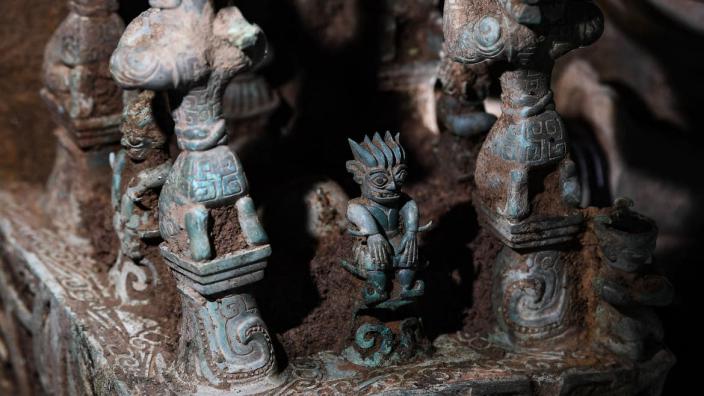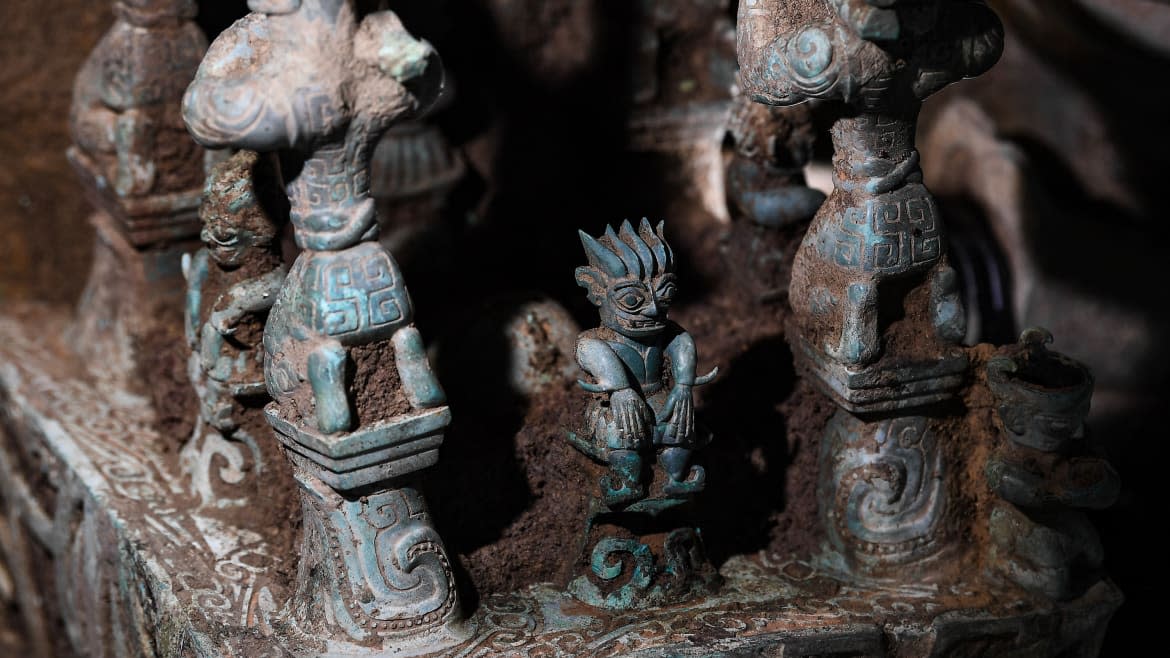
Archaeologists in China’s Sichuan province announced this week that they have found evidence of ancient attempts to interact with fairies. A cache of bronze, jade, and gold artifacts, as well as evidence of ancient sacrificial rituals, were unearthed. Some of the artifacts, scientists said, are unique objects that refer to the “fairy world” of ancient Chinese religion and thought. But when you envision your folk religion and Tinkerbell, think again.
The discoveries were made at the famous Sanxingdui archaeological site in the southwestern city of Guanghan in Sichuan Province. The true treasure trove was excavated from sacrificial pits 7 and 8 by a collaborative team of academics from Peking University and Sichuan University. One of the items was a bronze and green jade box embellished with dragon head handles and once wrapped in silk. Professor Li Haichao, of Sichuan University who heads pit 7, told Chinese news agencies: “It would not be an exaggeration to say that the vessel is unique, given its distinctive shape, fine craftsmanship and ingenious design.”
The collection of complex sculptures includes mythical creatures, human-snake hybrids and bronze heads decorated with golden masks. The iconographic program of the sculptures, which were mainly located in pit 8, is “complex and imaginative”. Zhao Hao, an associate professor at Peking University, said they “reflect the fairytale world envisioned by people at the time, and they demonstrate the diversity and richness of Chinese civilization.”
The finds receive a lot of attention, not only because of the historical importance of the site, but also because of the invocation of the word ‘fairy’ in media expressions. But “fairy” might be a misleading term here. The term is derived from Old English (fae) from Old French (faie) and refers to women who were skilled in magic or enchanted things and illusions. In pop culture, the word fairy in English-speaking countries is usually associated with Tinkerbell or, if you like to think of yourself as cultivated, Puck: winged, often undersized magical creatures associated with forests, the bottom of gardens, and wishes. In Chinese mythology, the entities described as “fairies” are often more powerful spirits associated with specific locations, especially mountains, rivers, and oceans.
These “ghosts” can be beneficent or evil and are sometimes related to former humans or animals that were transformed into local spirit guardians, ancestral spirits and gods. The Spirit-Guardian (Jingwei) of the mountain Departing-Doves, for example, was transformed into the Spirit-Guardian bird when she drowned in the Baltic Sea. A former mortal, Strassberg’s A Chinese Bestiary describes her as both a “goddess” and “spirit-keeper” and notes that the Taoists identify her as a “transcendent [human]’ and that in modern China she is a ‘symbol of one who refuses to accept defeat’. Jingwei’s story is about metamorphosis, and that fluidity is only enhanced by shifting interpretations of her status over time.
However, invoking the word “fairy” in news stories is enlightening, not only because of what it tells us about the discovery in question, but also because of the ways in which it exposes the exclusion of fairies from Western supernatural consciousness. If you look up ‘fairy’ in the Cambridge English Dictionary, you will learn that fairies are ‘imaginary’. Look up the more Christian-friendly “angel” and you’ll find a complete lack of existential judgments.
All this means that communicating with angels, spirits and fairies are not different kinds of activities. If talking to the fairies sounds lame, but sacrifices to the spirits are expected, then we are simply overwhelmed by the cultural biases of our own Christian-centered English language. In the irrevocably hierarchical patchwork of Anglo-American culture, fairies are at the bottom of the pecking order and have no chance of promotion. But Chinese mythology does not share our assumptions and differences. If the current interpretation is correct, the people of Sanxingdui were in contact with entities that could just as easily be described as ghosts or gods. The language of “fairy” describes the ways in which Chinese spirits and gods were often animal-human hybrids, but aesthetically, as the images from Sanxingdui reveal, they are very different. You won’t find any pixie cuts here.
” src=”https://s.yimg.com/ny/api/res/1.2/gO5xLEn6AvB6DDkdEHFvuA–/YXBwaWQ9aGlnaGxhbmRlcjt3PTcwNQ–/https://s.yimg.com/uu/api/res/1.2/G -~B/aD0wO3c9MDthcHBpZD15dGFjaHlvbg–/https://media.zenfs.com/en/thedailybeast.com/457701f3a5885a0e3ecce9d211d12196″ class=”caas-img”/>
1405746909
China News Service
Although scientists have not released precise dates for the most recent finds, the Sanxingdui ruins are 3500-4800 years old and experts have said the artifacts are about 3000-4500 years old. They are of immense importance to what they reveal about the Shu civilization, which thrived in the region until 316 BCE (when the region was conquered by the Qin dynasty). Archaeological research is the primary way to reconstruct this otherwise mysterious civilization, as literary references to the Shu state are largely mythological, dating back to the fourth century BCE. Chronicles of Huayang†
Previous studies of finds from Sanxingdui have noted that the culture that flourished there in the Bronze Age was contemporaneous with that of the Shang dynasty and has certain elements in common with its mythology and religion. Last but not least is the use of bronze offerings as a means of communicating with spirits. (This interpretation of the pits is disputed: Chen Shen argued in a 2002 book that the pits may have been burial grounds rather than sacrificial sites. There are no human remains in the pits).
In a report on a bronze statue found in sacrificial pit 1, Shen Zhongchang and Robert Jones write that during this period, “spirits were specifically worshiped in this way” in the Shang religion. At the same time, as Robert Bagley has written, “There is nothing in Shang archeology that prepares us for a bronze sculpture of the size and refinement” found in well 1. Bagley states that “the sacrificial ritual that produced the two [Sanxingdui] potholes [1 and 2 ] has no exact parallel elsewhere in Chinese archaeology and can only be associated in the most general way with the rituals that archaeologists have excavated at other Shang sites. Ran Honglin, of the Sichuan Provincial Cultural Relics and Archeology Research Institute, said of the recent finds that some elements of the sculpture were similar to artifacts from the Zhou Dynasty.
In other words, the finds from Sanxingdui are critical to what they can tell us about the contact between different kingdoms in ancient China, the development of metallurgical technologies and ancient Chinese religious rituals. The discovery of these more intricate and ornate offerings helps to color our rough sketch of both Shu cosmology and culture, and of what Honglin calls “early exchange and integration of Chinese civilization.” When Professor Hao spoke of the “fairytale world,” the focus of his statement was actually on the “diversity and richness of Chinese civilization.” The reports of ancient Chinese fairies, striking as they are, sell both the ancient deity spirits and the significance of the discoveries a bit short.
Read more at The Daily Beast.
Get Daily Beast’s biggest scoops and scandals straight to your inbox. Sign up now.
Stay informed and get unlimited access to Daily Beast’s unparalleled reporting. Subscribe now.

